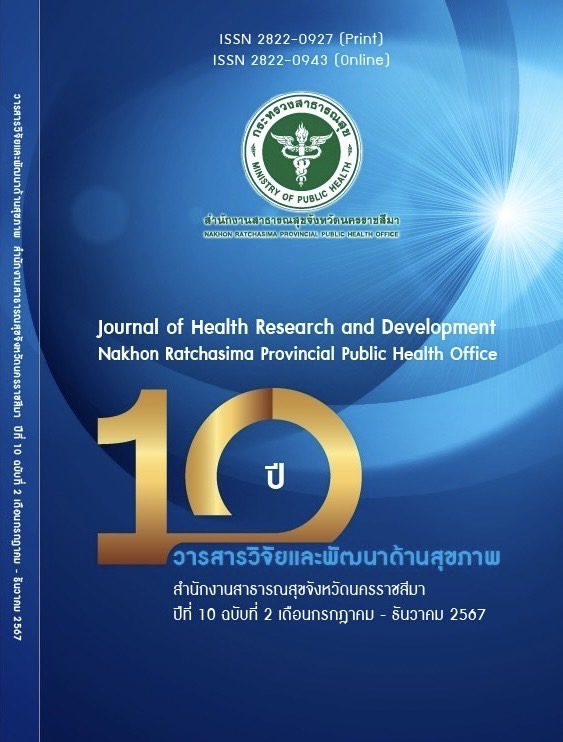Risk Factors Associated with Impaired Fasting Glucose and Diabetes Mellitus
Keywords:
Risk factors, Impaired Fasting Glucose (IFG), DiabetesAbstract
This was a descriptive cross-sectional study with the aim to study the factors affecting impaired fasting glucose (IFG) and diabetes mellitus type 2. Data was collected from patients and medical records of patients at NCD clinic at Suranaree University of Technology Hospital (SUTH) from November 1, 2023 to July 31, 2024. General data, risk factors, and laboratory test results were collected. The data were analyzed using descriptive statistics, including percentage, mean + standard deviation, and independent T-test.
A study of 115 patients who came for examination or treatment for diabetes found that three factors that influenced abnormal fasting blood sugar levels and diabetes were age, body mass index, and waist circumference. When comparing patients with abnormal fasting blood sugar levels and diabetes with normal blood sugar levels, they were found that patients with IFG and diabetes were 63.00+10.74 years old, and patients with normal blood glucose levels were 57.67+11.66 years old (p = 0.034). The body mass index (BMI) in patients with IFG and diabetes was 27.44+4.72 kg/m2. More than patients with normal blood glucose level 25.02+3.73 kg/m2 (p = 0.006). Waist circumference (WC) in patients with IFG and diabetes 39.56+4.47 inches more than patients with normal blood glucose level 35.01+3.93 inches. Both age, BMI and WC were significantly different when comparing patients with IFG and diabetes with patients with normal blood glucose level (p < 0.050). In conclusion, differences in age, BMI and WC, which are the modifiable factors, difference causes of IFG and diabetes.
References
Van der Schaft N, Brahimaj A, Wen KX, et al. The association between serum uric acid and the incidence of prediabetes and type 2 diabetes mellitus: The Rotterdam Study. PLoS One 2017;12(6) : e0179482.
Lv Q, Meng XF, He FF, et al. High serum uric acid and increased risk of type 2 diabetes: A systemic review and meta-analysis of prospective cohort studies. PLoS ONE 2013; 8(2): e56864.
El Ridi R, Tallima H. Physiological functions and pathogenic potential of uric acid: A review. J of Advanced Res 2017; 8(5): 487 – 93.
Jia L, Xing J, Ding Y, et al. Hyperuricemia causes pancreatic [5]β-cell death and dysfunction through NF-κB signaling pathway. PLoS One 2013; 8(10): e78284.
Sluijs I, Holmes MV, van der Schouw YT, et al. A Mendelian randomization study of circulating uric acid and type 2 diabetes. Diabetes 2015;64(8):3028 – 36.
Volpe A, Ye C, Hanley AJ, et al. Changes over time in uric acid in relation to changes in insulin sensitivity, beta-cell function, and glycemia. J Clin Endocrinol Metab 2020; 105(3): e651 – 59.
Pittas AG, Lau J, Hu FB, et al. The role of vitamin D and calcium in type 2 diabetes. A systematic review and meta-analysis. J Clin Endocrinol Metab 2007;92(6): 2017-29.
Pilla SJ, Balasubramanyam A, Knowler WC, et al. Islet autoantibody positivity in overweight and obese adults with type 2 diabetes. Autoimmunity 2018; 51: 408-16.
Bellou V, Belbasis L, Tzoulaki I, et al. Risk factors for type 2 diabetes mellitus: an exposure-wide umbrella review of meta-analyses. PLoS One 2018; 13: e0194127.
Haque T, Rahman S, Islam S, et al. Assessment of the relationship between serum uric acid and glucose levels in healthy, prediabetic and diabetic individuals. Diabetol Metab Syndr 2019;11 : 49.
Causevic A, Semiz S, Macic Dzankovic A, et al. Relevance of uric acid in progression of type 2 diabetes mellitus. Bosn J Basic Med Sci 2010; 10(1): 54 – 9.
Grover A, Mowar AB, Johri S. Prevalence of hyperuricemia in newly diagnosed type 2 diabetes mellitus patients. Int J Adv Med 2019; 6 :276 – 8.
Lee SB, Ahn CW, Lee BK, et al. Association between triglyceride glucose index and arterial stiffness in Korean adults. Cardiovasc Diabetol 2018;17 : 1 – 6.
Robertson RP, Harmon J, Tran POT, et al. β‐Cell glucose toxicity, lipotoxicity, and chronic oxidative stress in type 2 diabetes. Diabetes 2004; 53: S119 – 24.
Kahn AM, Allen JC, Seidel CL, et al. Insulin inhibits migration of vascular smooth muscle cells with inducible nitric oxide synthase. Hypertension 2000; 35 : 303 – 6.
Defronzo RA. From the triumvirate to the “ominous octet”: a new paradigm for the treatment of type 2 diabetes mellitus. Clin Diabetol 2009; 10: 101 – 28.
Kim MK, Ahn CW, Kang S, et al. Relationship between the triglyceride glucose index and coronary artery calcification in Korean adults. Cardiovasc Diabetol 2017; 16 : 1 – 7.
Zheng T, Ge B, Liu H, et al. Triglyceride‐mediated influence of serum angiopoietin‐like protein 8 on subclinical atherosclerosis in type 2 diabetic patients: results from the GDMD study in China. Cardiovasc Diabetol 2018;17:1-8.
Lindstrom J, Ilanne-Parikka P, Peltonen M, et al. Sustained reduction in the incidence of type 2 diabetes by lifestyle intervention: follow-up of the Finnish diabetes prevention study. Lancet 2006; 368: 1673 – 9.
Knowler WC, Fowler SE, Hamman RF, et al. 10-year follow-up of diabetes incidence and weight loss in the diabetes prevention program outcomes study. Lancet 2009; 374: 1677 – 86.
Tabák AG, Herder C, Rathmann W, Brunner EJ, Kivimäki M. Prediabetes: a high-risk state for diabetes development. The Lancet 2012; 379(9833): 2279 – 90.
Larsson H, Lindgärde F, Berglund G, Ahren B. Prediction of diabetes using ADA or WHO criteria in post-menopausal women: a 10-year follow-up study. Diabetologia 2000;43(10): 1224 – 8.
Downloads
Published
How to Cite
Issue
Section
License
Copyright (c) 2025 Nakhon Ratchasima Provincial Health Office

This work is licensed under a Creative Commons Attribution-NonCommercial-NoDerivatives 4.0 International License.
บทความที่ได้รับการตีพิมพ์เป็นลิขสิทธิ์ของสำนักงานสาธารณสุขจังหวัดนครราชสีมา กระทรวงสาธารณสุข
ข้อความที่ปรากฏในบทความแต่ละเรื่องในวารสารวิชาการเล่มนี้เป็นความคิดเห็นส่วนตัวของผู้เขียนแต่ละท่านไม่เกี่ยวข้องกับสำนักงานสาธารณสุขจังหวัดนครราชสีมา และบุคลากรท่านอื่นๆในสำนักงานฯ แต่อย่างใด ความรับผิดชอบองค์ประกอบทั้งหมดของบทความแต่ละเรื่องเป็นของผู้เขียนแต่ละท่าน หากมีความผิดพลาดใดๆ ผู้เขียนแต่ละท่านจะรับผิดชอบบทความของตนเองแต่ผู้เดียว


